Our House Antiques
Las Vegas, Nevada
Elegant Depression Era Glassware
Menu:
Misidentified or easily mistaken
Elegant Glassware Patterns
We have put together this page to assist people in identifying some patterns of Elegant Glass that are commonly mistaken for one another or which are frequently misidentified as to manufacturer or pattern name. The page is definitely to be considered a "work in progress", and we eagerly solicit suggestions as to how the page can be improved, and which patterns might be added to the list.
Pattern identification and comparison, by definition requires that we display pictures. Some of the photographs which feature side-by-side comparisons, will take a fair amount of time to load. When possible, we have provided a thumbnail image, which is much smaller. If you would like to see a larger picture, click on the thumbnail image and a larger picture will appear. In this way, we can cut down on the load time for the page, and let everyone enjoy the learning experience without having to wait forever for picture downloads.
Here is the index to the comparisons that we have made so far. Click on the one that interests you and you'll be taken directly there. All of these are on this web page, so you can simply scroll down if you choose to look at all of them. Have fun! This is for you, the visitor.
- Cambridge Turkeys and L. E. Smith Turkeys
- Those ROUND "Cambridge Glass" labels
- Comparing Fostoria "June" and "Romance"
- Comparing Fostoria "Navarre" and "Meadow Rose"
- Comparing Cambridge "Diane" and New Martinsville "Florentine"
- Comparing Cambridge "Rose Point", Tiffin "June Night" and "Cherokee Rose"
- Comparing Cambridge "Elaine", Lotus "Vesta" and Fostoria "Woodland"
- Fostoria "Coin" and Fenton "Coin Dot"
- Lotus Glass Company - Bridal Bouquet
Those ROUND "Cambridge Glass" labels
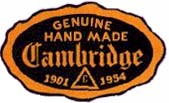
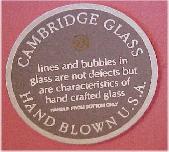
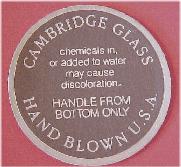 Most
Cambridge collectors are familiar with a label similar to the one
on the left (there were actually
several variations, over the course of the company's existance). But
the two labels on the right have been a bit of a mystery to
many collectors of Cambridge glass. To an experienced Cambridge
collector, these labels just aren't
right, and the type of glass that the labels appear on is
simply not at all like what we've grown to expect from the
Cambridge Glass Company of Cambridge, Ohio, that produced glass
from about 1901 through 1958.
Most
Cambridge collectors are familiar with a label similar to the one
on the left (there were actually
several variations, over the course of the company's existance). But
the two labels on the right have been a bit of a mystery to
many collectors of Cambridge glass. To an experienced Cambridge
collector, these labels just aren't
right, and the type of glass that the labels appear on is
simply not at all like what we've grown to expect from the
Cambridge Glass Company of Cambridge, Ohio, that produced glass
from about 1901 through 1958.
Well, the mystery has been solved. The round labels are actually affixed to glass that was made in the Cambridge factory in Cambridge, Ohio, but only after the original Cambridge Glass Company went out of business. Those round labels belonged to the Super Glass Company of Brooklyn, New York !! The National Cambridge Collectors web site has an article which explains how it came to pass that a New York company made glass in Cambridge, Ohio, and labeled it as "Cambridge Glass". CLICK HERE to be taken to the NCC web site and the article in question. You'll be fascinated by the story. You can use your Browser's "BACK" button to return here when you're done.
Comparison of Cambridge and L. E. Smith glass Turkeys
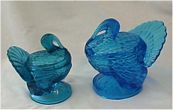 The glass turkey containers made by Cambridge and L. E. Smith Glass Companies
(shown in the thumbnail - click on it to see a larger photo)
tend to be confused with one another by even some of the most experienced glass
collectors and dealers, yet the differences are quite easy to spot, once you know
what to look for. Here are two easy ways to tell them apart.
The glass turkey containers made by Cambridge and L. E. Smith Glass Companies
(shown in the thumbnail - click on it to see a larger photo)
tend to be confused with one another by even some of the most experienced glass
collectors and dealers, yet the differences are quite easy to spot, once you know
what to look for. Here are two easy ways to tell them apart.
First, the size difference is obvious from the photo. But all you have to do is curl your fist into a ball and place it inside the body of the turkey. With the Smith turkey, you can fit ONE fist inside the body. However, the Cambridge turkey will easily fit TWO fists from most people.
The second test is visual. Set the turkey on the table, with the lid on. On the Smith turkey, the base of the lid will be parallel to the top of the table (i.e. the lid fits on flat). On the Cambridge turkey, the lid is on a definite slant, and is NOT parallel to the table top.
Using the photo above and the two tests described above, you should now have no difficulty in distinguishing the Cambridge turkey from its smaller cousin made by L. E. Smith glass company (and the Smith turkey was available for sale by L. E. Smith as recent as the fall of 2006, at their web site: www.lesmithglass.com).
Comparison of Fostoria "June" and "Romance"

 These two patterns are very commonly
confused. Both have a ribbon with a bow, and both have
flowers interspersed with the ribbon. You will notice from
the closeups of the two patterns that there are significant
differences that are easily seen when the patterns are placed
side-by-side.
These two patterns are very commonly
confused. Both have a ribbon with a bow, and both have
flowers interspersed with the ribbon. You will notice from
the closeups of the two patterns that there are significant
differences that are easily seen when the patterns are placed
side-by-side.

 The above two pictures should give
you a very good comparison between Fostoria's "June" and
"Romance" patterns. "Romance", shown on the right, was never
made in colors, while "June", pictured on the left, was
offered in three colors (pink, azure blue, and topaz yellow)
plus crystal. The stemware used for the two patterns was
quite different as illustrated below, and even the blanks
used for plates, bowls, candlesticks, etc., were quite
different. There was a period when production of the two
patterns overlapped. The two patterns can be
intermixed, but to the purist, there is a definite and
distinct difference.
The above two pictures should give
you a very good comparison between Fostoria's "June" and
"Romance" patterns. "Romance", shown on the right, was never
made in colors, while "June", pictured on the left, was
offered in three colors (pink, azure blue, and topaz yellow)
plus crystal. The stemware used for the two patterns was
quite different as illustrated below, and even the blanks
used for plates, bowls, candlesticks, etc., were quite
different. There was a period when production of the two
patterns overlapped. The two patterns can be
intermixed, but to the purist, there is a definite and
distinct difference.
Comparison of Fostoria "Navarre" and "Meadow Rose"

 Fostoria really went out of their
way to confuse folks with these two patterns. Not only are
the etchings similar, but both patterns were produced on the
same stemware blanks and many of the same flatware blanks as
well.
Fostoria really went out of their
way to confuse folks with these two patterns. Not only are
the etchings similar, but both patterns were produced on the
same stemware blanks and many of the same flatware blanks as
well.

 The above two pictures should give
you a comparison between Fostoria's "Navarre" and "Meadow
Rose" patterns. Click on either one to see the two patterns
side-by-side. "Navarre", shown on the left, was originally
made only in crystal, while "Meadow Rose", pictured on the
right, was offered in crystal and azure (light blue)
originally, but the blue color was discontinued before the
end of WW II. The stemware blank used for the two patterns
was identical, which is why the two patterns are often
confused with each other.
The above two pictures should give
you a comparison between Fostoria's "Navarre" and "Meadow
Rose" patterns. Click on either one to see the two patterns
side-by-side. "Navarre", shown on the left, was originally
made only in crystal, while "Meadow Rose", pictured on the
right, was offered in crystal and azure (light blue)
originally, but the blue color was discontinued before the
end of WW II. The stemware blank used for the two patterns
was identical, which is why the two patterns are often
confused with each other.
The "Navarre" pattern was produced by Fostoria from 1936 to 1982, making it the most popular of all of Fostoria's etched patterns. "Navarre" stemware was produced in colors beginning in 1973 (so colored "Navarre" is definitely not depression glass). The stemware was done in azure (blue) and a light pink that is distinctly different from the pink of the depression era. The "Navarre" line also included some stemware shapes that were not made in "Meadow Rose", including a "Continental Champagne" (flute shape), a "Magnum" (very large oversized bowl), a "Sherry" and a "Brandy" (snifter). Colored stemware in "Navarre" is usually "signed" on the bottom - but Fostoria sold the "Navarre" pattern to Lenox in 1983, and Lenox continued production of the stemware for four more years. The Lenox-produced stemware is often "signed" Lenox, and the pink color appears to be somewhat different from Fostoria's pink.
Comparison
of Cambridge "Diane" and
New Martinsville "Florentine"

 These two patterns are remarkably
similar, despite the fact that they were done by two
different companies. New Martinsville "Florentine" is a
pattern that is not recognized by many people, while
Cambridge "Diane" is more easily found and is usually
identified correctly.
These two patterns are remarkably
similar, despite the fact that they were done by two
different companies. New Martinsville "Florentine" is a
pattern that is not recognized by many people, while
Cambridge "Diane" is more easily found and is usually
identified correctly.
Click on the photograph of either platter and you will be presented with a larger image of the two platters side by side. If you CLICK HERE, you will see a closeup of the two patterns side by side. There is a "horseshoe" shaped construct in both patterns that is the dominant feature, but on "Florentine" the "horseshoe legs" point towards the outside edge of the piece, while with "Diane", the "legs" point inward. The remaining decorations appear to be grape vines and fruit on "Florentine", while on "Diane" they are flowers.
 To the
left is a photograph of Cambridge's "Diane" pattern on the
#3122 blank. I have never seen any stemware in "Florentine"
and have therefore no photograph to show you. You may find
"Diane" on other Cambridge stemware blanks, but the one
illustrated is the most commonly seen stem. Click on the
photo to see it enlarged for you.
To the
left is a photograph of Cambridge's "Diane" pattern on the
#3122 blank. I have never seen any stemware in "Florentine"
and have therefore no photograph to show you. You may find
"Diane" on other Cambridge stemware blanks, but the one
illustrated is the most commonly seen stem. Click on the
photo to see it enlarged for you.
Cambridge "Rose Point", Tiffin "June Night" and "Cherokee Rose"
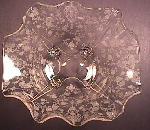 These three patterns cause no end of
problems when it comes to identifying Elegant
Glassware.
These three patterns cause no end of
problems when it comes to identifying Elegant
Glassware.
Rose Point (left), by Cambridge Glass Company of Cambridge, OH, is
one of the most popular and extensive patterns available. It
was made in literally hundreds of different shapes,
and sold for nearly 30 years by Cambridge until they closed
in 1958. After that, some pieces were made by Imperial Glass
Company, which purchased the Cambridge molds (and everything
else) when Cambridge went out of business.
Tiffin Glass Company, of Tiffin, OH, was another
large producer of quality glassware operating at the same
time as Cambridge. Two patterns by Tiffin, June Night
and Cherokee Rose, are fairly similar to Rose


 Point from a distance, but when you carefully look at the
patterns, they are quite distinctive, and really shouldn't be
mistaken for one another. Click on the picture of the
Rose Point bowl (above left) to see a much larger
picture that compares the three patterns, close-up (it's a
big picture, and you'll need to scroll down to see it
all).
Point from a distance, but when you carefully look at the
patterns, they are quite distinctive, and really shouldn't be
mistaken for one another. Click on the picture of the
Rose Point bowl (above left) to see a much larger
picture that compares the three patterns, close-up (it's a
big picture, and you'll need to scroll down to see it
all).
Click on the picture of the three stems (at left) to see the stemware for the three patterns compared side-by-side. Note that only two of the numerous stems that were done in Rose Point are shown - stem #3121 which is the most popular shape, and #3500 which comes in second. Both the June Night and Cherokee Rose patterns come on several different Tiffin stems besides the ones pictured.
Comparison of Cambridge "Elaine",
Lotus "Vesta"
and Fostoria "Woodland"


 Here are a few more patterns that are easily confused with each other. You can
click on each of the small photos to see a larger image. They are alike in that
the curl at the end of the stem looks quite similar in each pattern.
Here are a few more patterns that are easily confused with each other. You can
click on each of the small photos to see a larger image. They are alike in that
the curl at the end of the stem looks quite similar in each pattern.
The goblet on the left is ELAINE, a rather popular and extensive pattern made by the Cambridge Glass Company through the 1930s and 1940s. ELAINE is found on several different stemware lines - the one in the photo is line #3035.
A very close match is the goblet illustrated in the second photo, the VESTA pattern by Lotus Glass Company, also made in the 1930s and 1940s. Since Lotus did not make glass (they bought undecorated glass from various manufacturers), VESTA is found on glass made by several different companies, including Cambridge. The bulk of the pattern appears to be done on Heisey blanks.
The third pattern is WOODLAND, an older pattern manufactured by Fostoria Glass Company in the 1920s. While not an extensive pattern, the design is definitely similar to the two patterns mentioned above. When the piece was trimmed with gold, the pattern name was changed to GOLDWOOD as in the goblet photograph. This pattern is close enough to ELAINE and VESTA to warrant its inclusion here.
Comparison of Fostoria "COIN" and
Fenton's "Coin Dot"

 The NAME of these two patterns are
often confused. But that's the only confusing thing.
Fostoria's pattern actually has "coins" molded into the glass
(they're not real coins, but constructed to look like coins).
Fenton's "Coin Dot" pattern is produced by using a "spot
mold" to create round "dots" in the piece, and it's because
these "dots" resemble coins that the pattern got its name.
You will notice from the closeups of the two patterns that
there are significant differences that are easily seen when
the patterns are placed side-by-side.
The NAME of these two patterns are
often confused. But that's the only confusing thing.
Fostoria's pattern actually has "coins" molded into the glass
(they're not real coins, but constructed to look like coins).
Fenton's "Coin Dot" pattern is produced by using a "spot
mold" to create round "dots" in the piece, and it's because
these "dots" resemble coins that the pattern got its name.
You will notice from the closeups of the two patterns that
there are significant differences that are easily seen when
the patterns are placed side-by-side.
The above two pictures should give you a very good comparison between Fostoria's "Coin" and Fenton's "Coin Dot" patterns. "Coin Dot", shown on the right, has the "holes" or "dots", while Fostoria's "Coin" pattern (on the left) has distinctive "coins" molded into the piece.
Lotus Glass Company's "Bridal Bouquet" pattern
 This pattern has driven me
absolutely nuts over the years. I have seen it many times,
and maybe even found the manufacturer once or twice and then
forgotten it again. At last, I've gotten
a page from the Lotus
Glass Company's 1944 Catalog, which lists a number of
pieces in the pattern. Or click the thumbnail at left to see
a larger image of a platter in this pattern.
This pattern has driven me
absolutely nuts over the years. I have seen it many times,
and maybe even found the manufacturer once or twice and then
forgotten it again. At last, I've gotten
a page from the Lotus
Glass Company's 1944 Catalog, which lists a number of
pieces in the pattern. Or click the thumbnail at left to see
a larger image of a platter in this pattern.
Now, I know why it has driven me crazy. Lotus Glass Company never made a piece of glass! They purchased "blanks" from various glass companies, and then added their own decorations to the glassware. Lotus did acid etchings, cuttings, enamel decorations, gold encrustation, platinum trim, gold trim - just about anything you could do to decorate a plain piece of glass. Then they sold the product as their own work (which is quite legitimate, just confusing to us glass dealers, that's all). The "Charlton" decoration that you often find on Cambridge "Crown Tuscan" pieces was done by Abels, Wasserberg of New York, and they, too, bought the "blanks" from Cambridge and sold the finished decorated pieces as their own product.
The catalog page, which you can see by CLICKING HERE, shows quite a few pieces of the "Bridal Bouquet" pattern, and the interesting observation is that to me, it looks like there are at least THREE glass companies represented on this one page. The covered candy #797, is Paden City's #444 "Alexander" candy jar. The handled platter #728 is a piece of Cambridge glass for sure. And I am almost certain that the cheese and cracker set, #724 was done by Fostoria. No wonder I was going nuts trying to figure out who made this pattern!
So here you can see why even experienced glass dealers sometimes are confused by who made a particular piece of glass. Given any one of the pieces individually, we might correctly identify the maker of the piece of glass, but not the pattern. However, seeing all the pieces together on a catalog page from Lotus explains the mystery.
We welcome your suggestions for other patterns to be included on this page. Thank you for your visit.